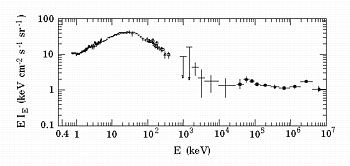
2.3.3 CLUSTERS
The detection of hard X-ray emission from inverse Compton scattering
of 2.7 K background photons from high-energy intracluster electrons would
provide a very direct way of investigating intergalactic magnetic fields.
The presence of electrons is inferred from the observation of cluster radio
halos. The Coma cluster is the best known example, but others include A2255,
A2256, A2319, and A1367. The origin of the magnetic fields in galaxy clusters
is not understood, nor is the mechanism by which the electrons are accelerated.
Since we cannot be confident of equipartition, the magnetic field cannot
be estimated from the radio observations alone. Observation of the inverse
Compton X-rays together with the radio observations would provide a much
more direct method of establishing the magnetic fields, but requires X-ray
observations above about 20 keV to avoid confusion from thermal emission.
An estimated flux sensitivity of ~3 x 10-6 photons cm-2 s-1 keV-1 in the
~20-60 keV range is needed to make the crucial measurement. While HEXTE
will attempt this, imaging instruments are needed to avoid confusion with
cluster AGNs. High spectral resolution in the hard X-ray band is also needed
for a clean separation of the thermal cluster gas component. Focusing hard
X-ray telescopes, with high resolution detectors, are particularly well
suited to this important problem.
2.3.4 THE DIFFUSE GAMMA-RAY BACKGROUND
Data on the cosmic diffuse gamma-ray background has been obtained by
over 20 balloon- and satellite-borne instruments over the past 30 years,
but only recently have good spectral measurements been made. Many questions
remain unanswered though, such as the spectral shape in the MeV region,
the presence or absence of nucleosynthetic lines, the angular distribution,
and the origin of the radiation. The low-energy portion of the cosmic diffuse
spectrum (10 keV to 60 keV) is characterized by a bremsstrahlung spectral
form that can be approximated by a power-law segment of energy index ~0.4.
The energy spectrum transitions to a power law of index ~1.6 above 60 keV.
At an MeV, there is still uncertainty as to the shape. Prior to 1995, the
spectrum was thought to have a hump at ~2 MeV as detected by instruments
on balloons, HEAO-1, and Apollo 16/17. However, recent measurements by
the COMPTEL instrument on Compton in the 0.8 - 30 MeV range, and a careful
reanalysis of data obtained with SMM, have not detected the hump. Above
several MeV the spectrum has an energy index of ~1.0 as seen by recent
measurements by EGRET.

Figure 2.3.4 - The diffuse background from soft X-rays to high-energy gamma-rays.
Various theoretical attempts have been made to model the source of the
diffuse background as unresolved AGN. It is generally possible to fit the
spectrum with dominant contributions from absorbed Seyfert 2's between
10 and 400 keV and blazars between 3 MeV and 10 GeV. There may be an excess
emission at ~1 MeV above the AGN models, although the data quality is not
good in this range. The origin of such an excess could be gamma-ray line
and continuum emission from unresolved Type 1a supernovae.
Objectives:
Requirements:
2.4 THE PUZZLE OF THE UNIDENTIFIED HIGH-ENERGY GAMMA-RAY
SOURCES
Only 45% of the gamma-ray sources detected by EGRET have been
identified with sources known at longer wavelengths. The nature of the
remaining sources is an important question. The distribution of these unidentified
sources suggests a largely galactic population; however, there are some
at high galactic latitudes.